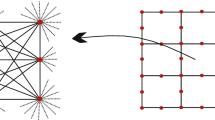Abstract
Global optimization remains an important area of active research. Many macroscopic and microscopic applications in science and engineering still present formidable challenges to current global optimization techniques. In this work, a completely different, novel and general geometric framework for continuous global optimization is described. The proposed methodology is based on intelligent movement along the valleys and ridges of an appropriate objective function using downhill, local minimization calculations defined in terms of a trust region method and uphill integration of the Newton-like vector field combined with intermittent SQP corrector steps. The novel features of the proposed methodology include new rigorous mathematical definitions of valleys and ridges, the combined use of objective function and gradient surfaces to guide movement, and techniques to assist both exploration and termination. Collisions with boundaries of the feasible region, integral curve bifurcations, and the presence of non-differentiabilities are also discussed. A variety of examples are used to make key concepts clear and to demonstrate the reliability, efficiency and robustness of terrain methods for global optimization.
Similar content being viewed by others
References
Aluf-Pentini, F., Parisi, V. and Zirilli, F. (1985), Global optimization and stochastic differential equations, J.Opt.Theory and Appl.47, 1-15.
Bahren, J. and Protopopescu, V. (1996), Generalized TRUST algorithms for global optimiza-tion, In State of the Art in Global Optimization, Kluwer Academic Publishers, Dordrecht, pp.163-180.
Baker, J. (1986), An algorithm for the location of transition states, J.Comput.Chem.7, 385-395.
Bilbro, G.L. (1994), Fast stochastic global optimization, IEEE Trans.Syst.Man.Cyber.SMC-24 4, 684-689.
Bolhius, P.G., Chandler, D., Dellago, C. and Geissler, P.L. (2002), Transition path sampling: Throwing ropes over rough mountain passes, in the dark, Annu.Rev.Phys.Chem.53, 291-318.
Hansen, E.R. (1980), Global optimization using interval analysis-the multidimensional case, Numer.Math.34, 247-270.
Henkelman, G., Johannesson, G. and Jonsson, H. (2000), Methods for nding saddle points and minimum energy paths, In:Progress in Theoretical Chemistry and Physics, 5, pp.269-300, Kluwer Academic Publishers, Dordrecht, The Netherlands.
Levy, A.V. and Montalvo, A. (1985), The tunneling algorithm for the global minimization of functions, SIAM J.Sci. and Stat.Comp.6, 15-29.
Lucia, A. and Yang, F. (2002), Global terrain methods, Comput.Chem.Engng.26, 529-546.
Lucia, A. and Yang, F. (2003), Multivariable terrain methods, AIChE J.in press.
Maranas, C.D. and Floudas, C.A. (1995), Finding all solutions to nonlinearly constrained systems of equations, J.Global Optim.7, 143-153.
Michelsen, M.L. (1982), The isothermal.ash problem.Part 1.stability, Fluid Phase Equil.9, 1-19.
Muller, K. and Brown, L.D. (1979), Location of saddle points and minimum energy paths by a constrained simplex optimization procedure, Theoret.Chim.Acta, 53, 75-93.
Prausnitz, J.M., Anderson, T.F., Grens, E.A., Eckert, C.A., Hsieh, R. and O'Connell, J.P. (1980), Computer Calculations for Multicomponent Vapor-Liquid and Liquid-Liquid Equilib-ria, Prentice-Hall, Englewood Cliffs, NJ.
Schnepper, C.A. and Stadtherr, M.A. (1995), Robust process simulation using interval methods, Comput.Chem.Engng.20, 187-199.
Sevick, E.M., Bell, A.T. and Theodorou, D.N. (1993), A chain of states method for investigating infrequent event processes occurring in multistate, multidimensional systems, J.Chem.Phys. 98, 3196-3212.
Westerberg, K.M. and Floudas, C.A. (1999), Locating all transition states and studying the reaction pathways of potential energy functions, J.Chem.Phys.110, 9259-9295.
Author information
Authors and Affiliations
Rights and permissions
About this article
Cite this article
Lucia, A., Dimaggio, P. & Depa, P. A Geometric Terrain Methodology for Global Optimization. Journal of Global Optimization 29, 297–314 (2004). https://doi.org/10.1023/B:JOGO.0000044771.25100.2d
Issue Date:
DOI: https://doi.org/10.1023/B:JOGO.0000044771.25100.2d




